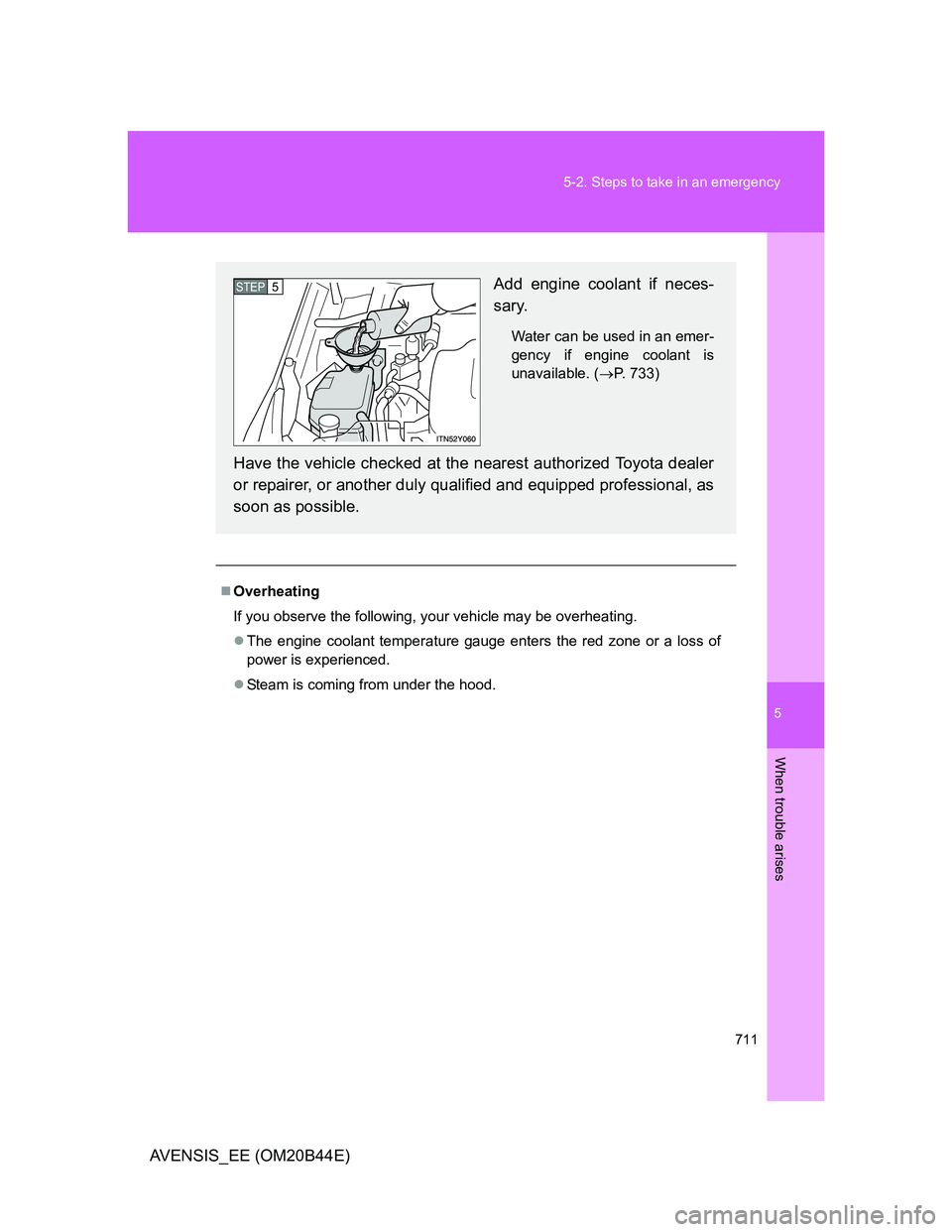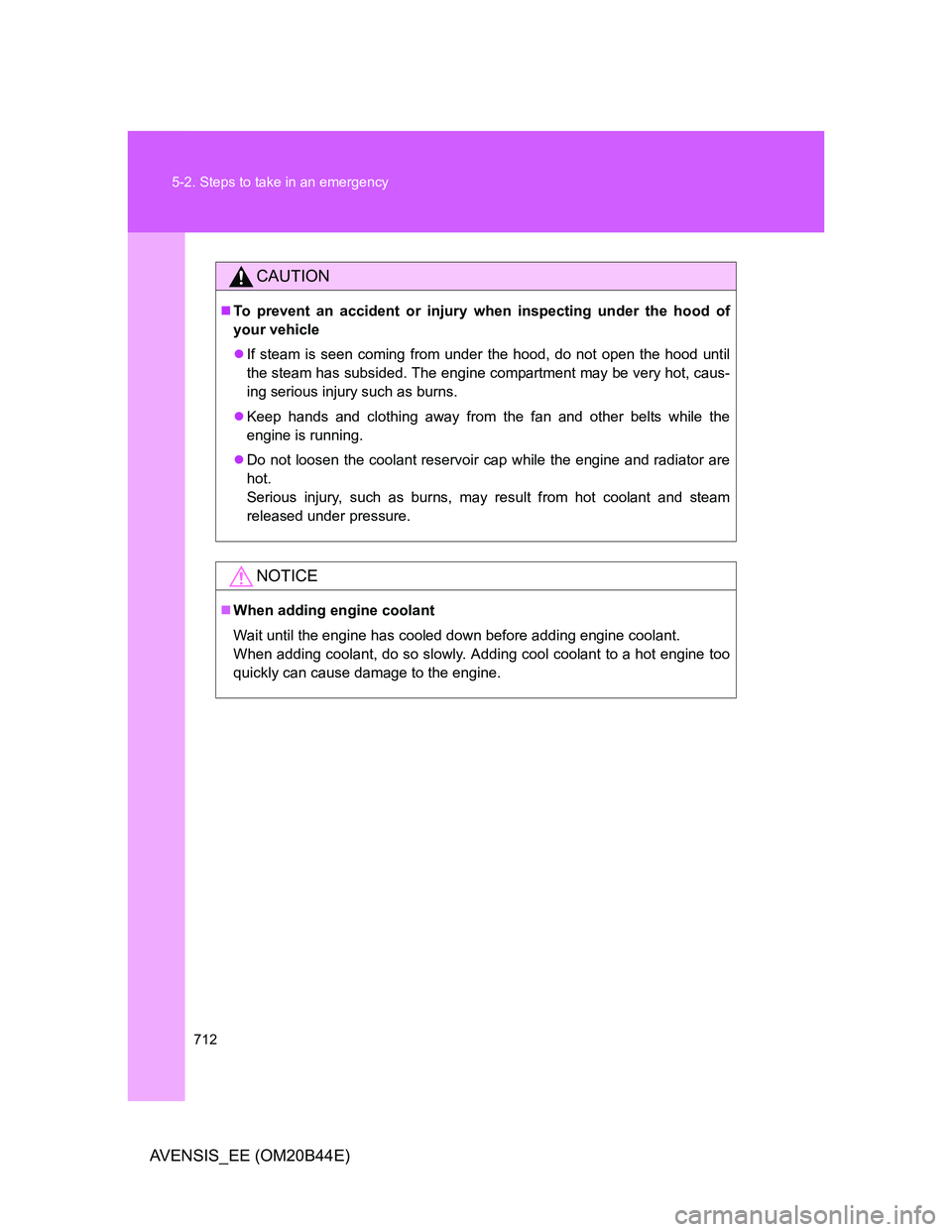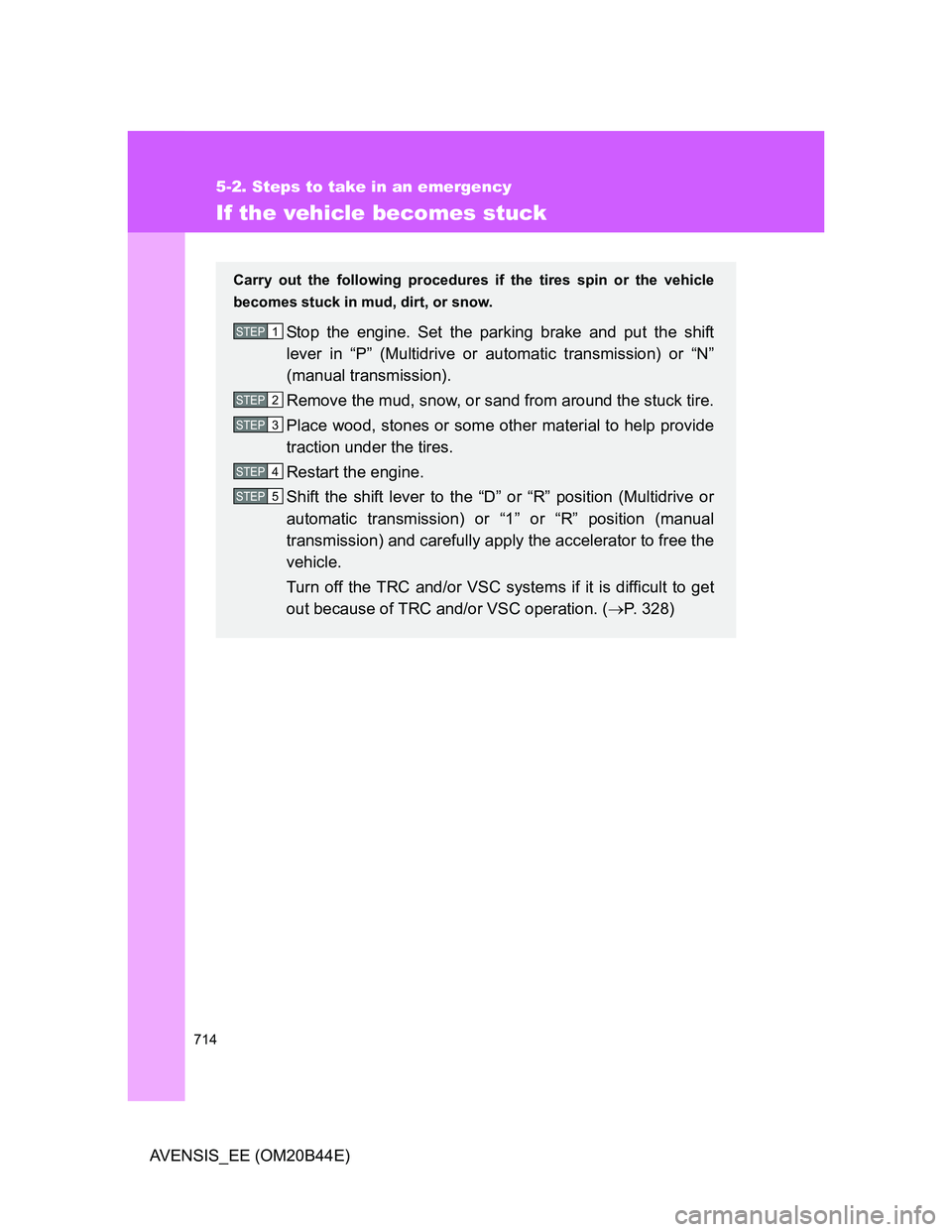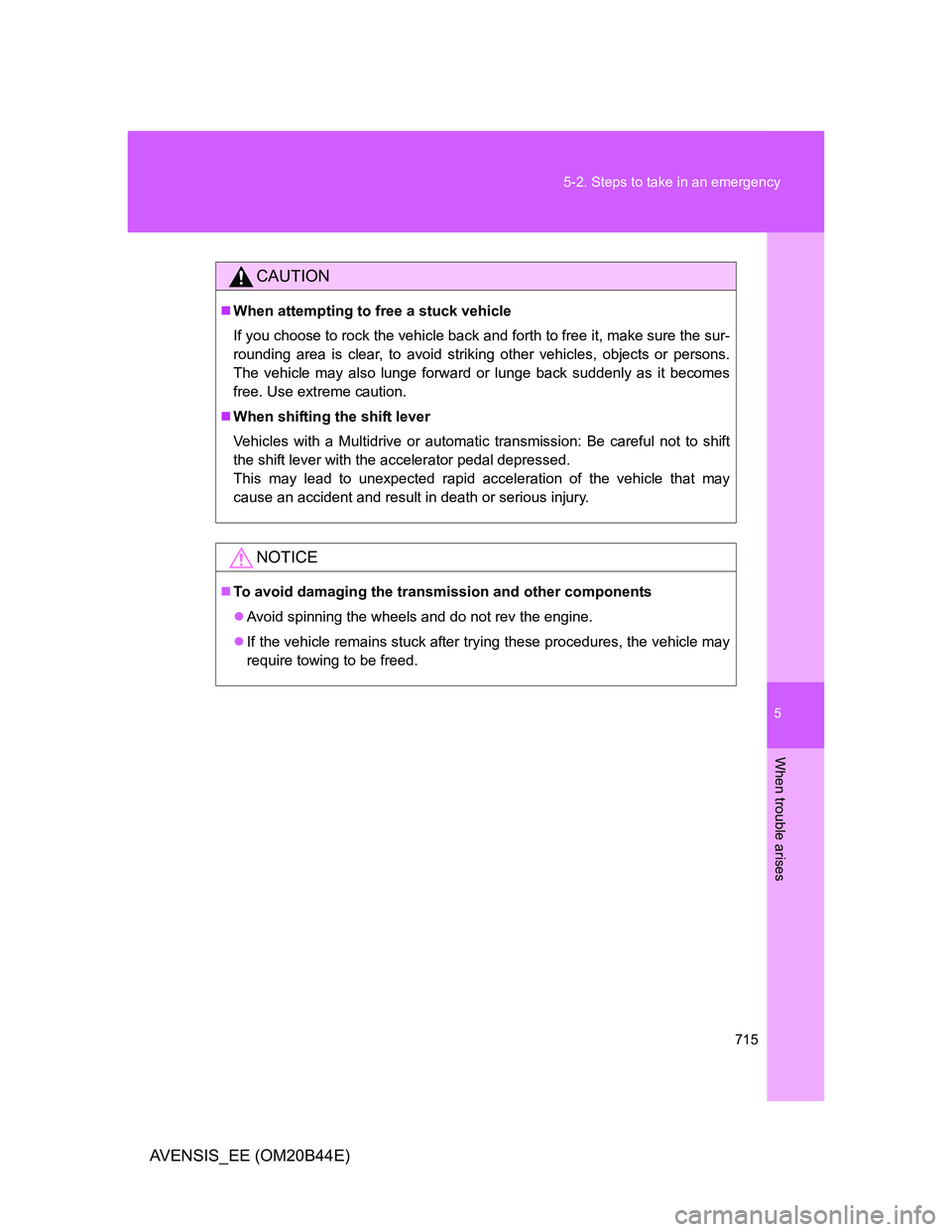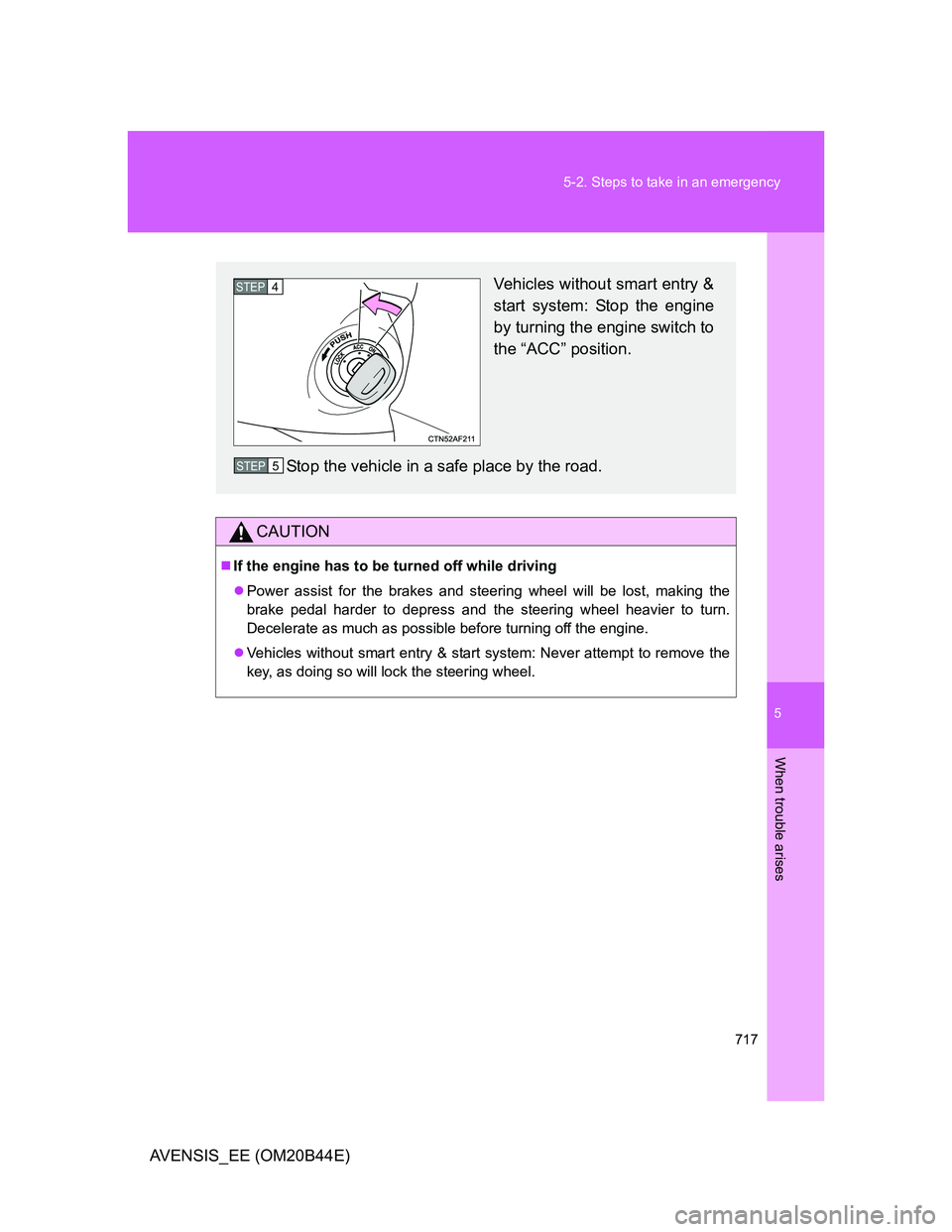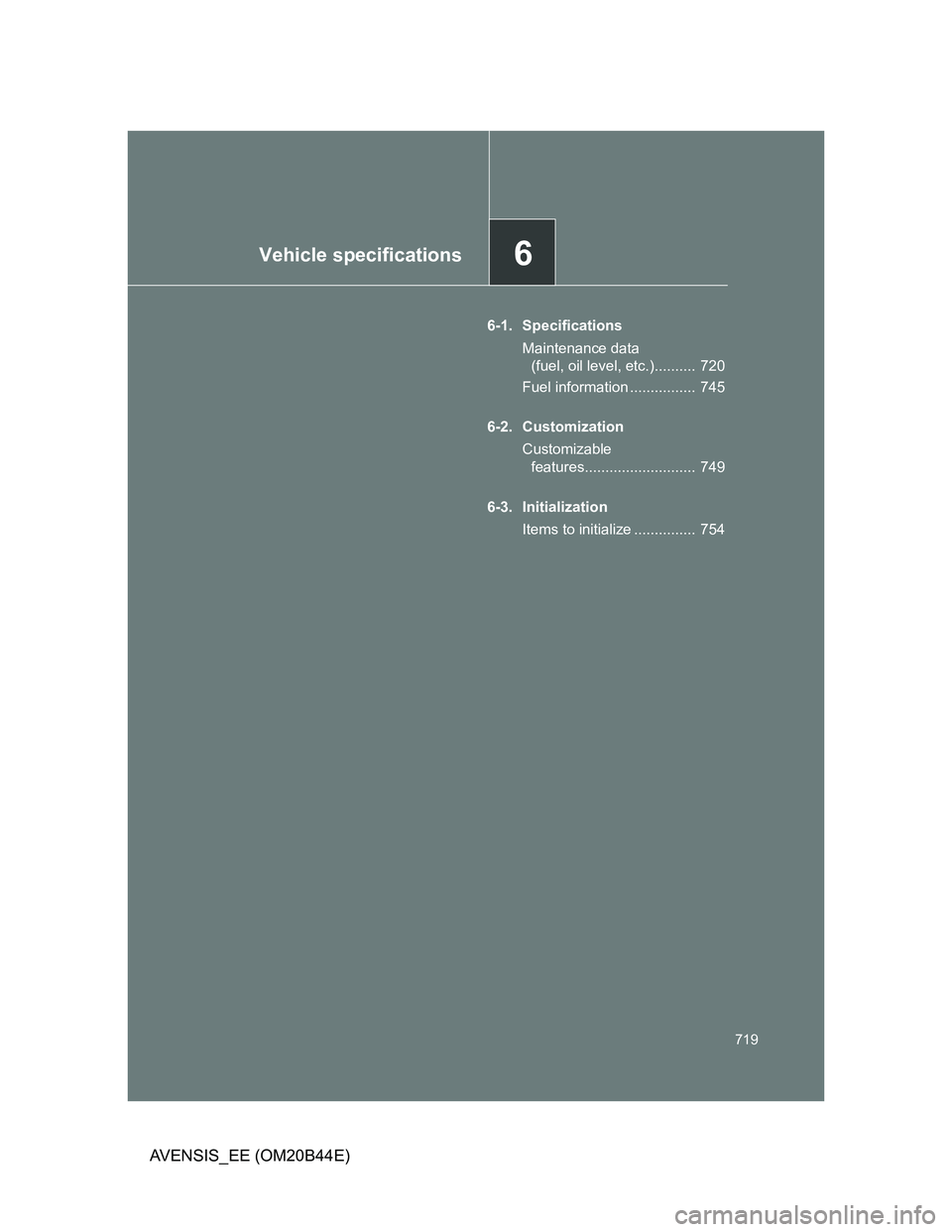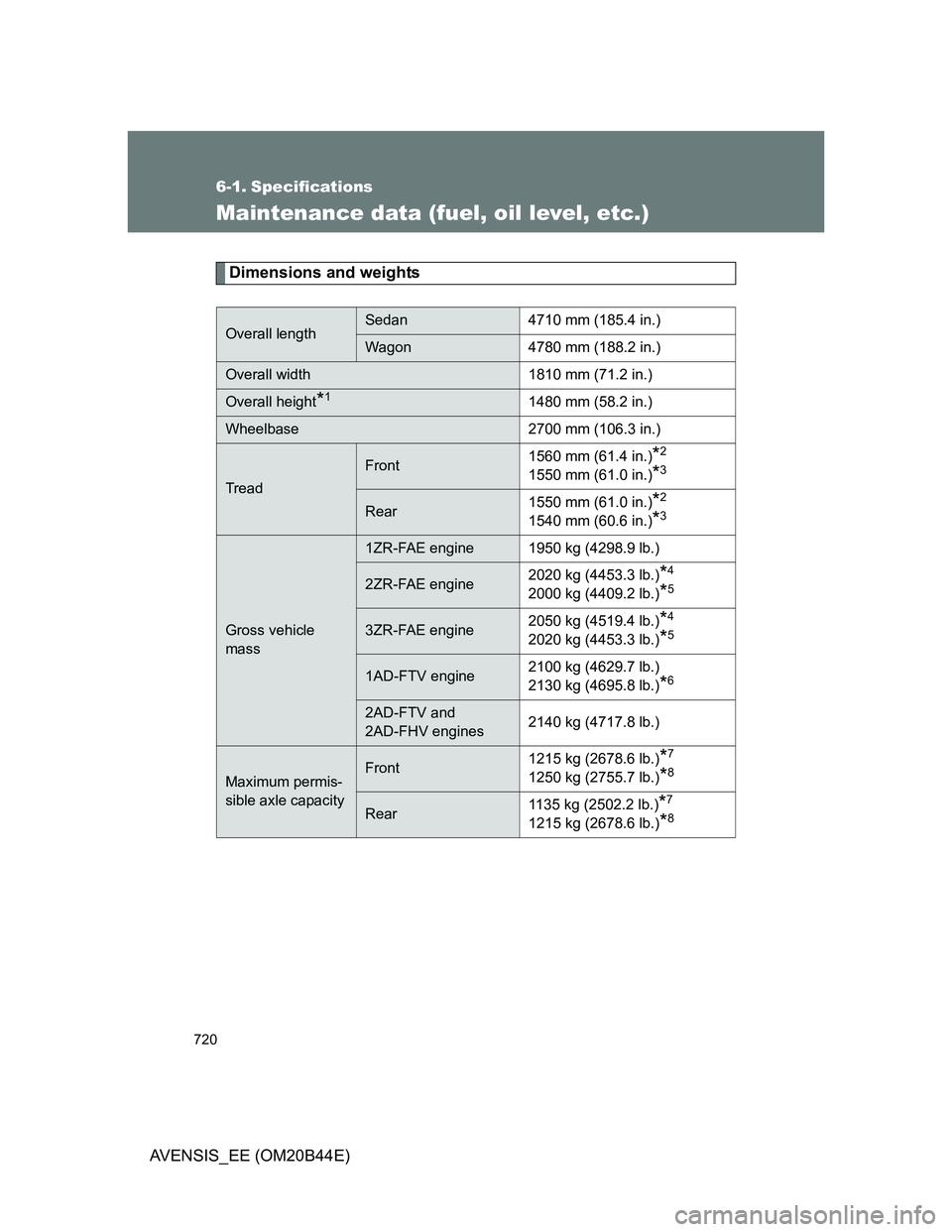TOYOTA AVENSIS 2012 Owners Manual
AVENSIS 2012
TOYOTA
TOYOTA
https://www.carmanualsonline.info/img/14/59673/w960_59673-0.png
TOYOTA AVENSIS 2012 Owners Manual
Trending: key, instrument panel, overheating, engine overheat, engine oil, head light replacement, width
Page 711 of 772
5
711 5-2. Steps to take in an emergency
When trouble arises
AVENSIS_EE (OM20B44E)
Overheating
If you observe the following, your vehicle may be overheating.
The engine coolant temperature gauge enters the red zone or a loss of
power is experienced.
Steam is coming from under the hood.
Add engine coolant if neces-
sary.
Water can be used in an emer-
gency if engine coolant is
unavailable. (P. 733)
Have the vehicle checked at the nearest authorized Toyota dealer
or repairer, or another duly qualified and equipped professional, as
soon as possible.
STEP5
Page 712 of 772
712 5-2. Steps to take in an emergency
AVENSIS_EE (OM20B44E)
CAUTION
To prevent an accident or injury when inspecting under the hood of
your vehicle
If steam is seen coming from under the hood, do not open the hood until
the steam has subsided. The engine compartment may be very hot, caus-
ing serious injury such as burns.
Keep hands and clothing away from the fan and other belts while the
engine is running.
Do not loosen the coolant reservoir cap while the engine and radiator are
hot.
Serious injury, such as burns, may result from hot coolant and steam
released under pressure.
NOTICE
When adding engine coolant
Wait until the engine has cooled down before adding engine coolant.
When adding coolant, do so slowly. Adding cool coolant to a hot engine too
quickly can cause damage to the engine.
Page 713 of 772
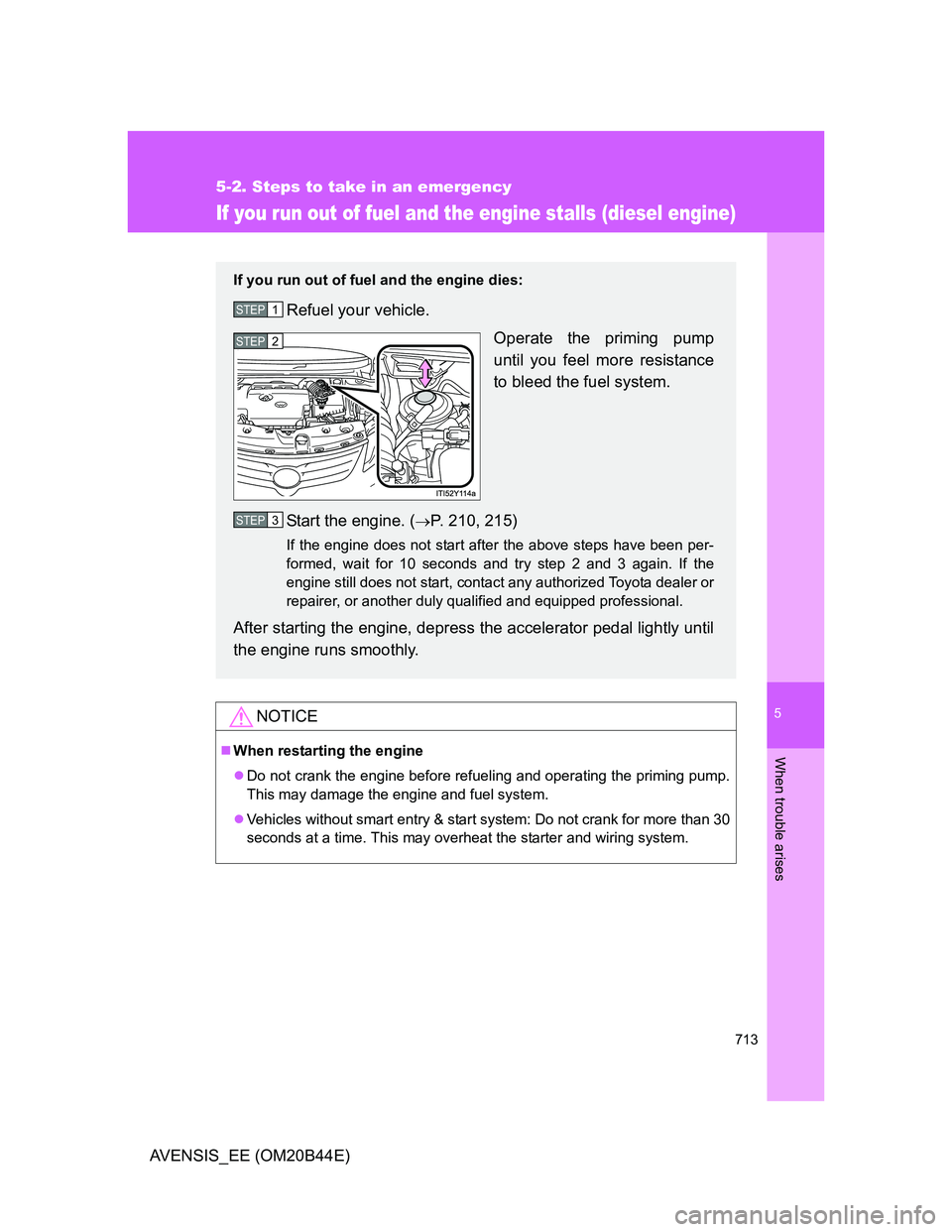
5
713
5-2. Steps to take in an emergency
When trouble arises
AVENSIS_EE (OM20B44E)
If you run out of fuel and the engine stalls (diesel engine)
NOTICE
When restarting the engine
Do not crank the engine before refueling and operating the priming pump.
This may damage the engine and fuel system.
Vehicles without smart entry & start system: Do not crank for more than 30
seconds at a time. This may overheat the starter and wiring system.
If you run out of fuel and the engine dies:
Refuel your vehicle.
Operate the priming pump
until you feel more resistance
to bleed the fuel system.
Start the engine. (
P. 210, 215)
If the engine does not start after the above steps have been per-
formed, wait for 10 seconds and try step 2 and 3 again. If the
engine still does not start, contact any authorized Toyota dealer or
repairer, or another duly qualified and equipped professional.
After starting the engine, depress the accelerator pedal lightly until
the engine runs smoothly.
STEP1
STEP2
STEP3
Page 714 of 772
714
5-2. Steps to take in an emergency
AVENSIS_EE (OM20B44E)
If the vehicle becomes stuck
Carry out the following procedures if the tires spin or the vehicle
becomes stuck in mud, dirt, or snow.
Stop the engine. Set the parking brake and put the shift
lever in “P” (Multidrive or automatic transmission) or “N”
(manual transmission).
Remove the mud, snow, or sand from around the stuck tire.
Place wood, stones or some other material to help provide
traction under the tires.
Restart the engine.
Shift the shift lever to the “D” or “R” position (Multidrive or
automatic transmission) or “1” or “R” position (manual
transmission) and carefully apply the accelerator to free the
vehicle.
Turn off the TRC and/or VSC systems if it is difficult to get
out because of TRC and/or VSC operation. (P. 328)STEP1
STEP2
STEP3
STEP4
STEP5
Page 715 of 772
5
715 5-2. Steps to take in an emergency
When trouble arises
AVENSIS_EE (OM20B44E)
CAUTION
When attempting to free a stuck vehicle
If you choose to rock the vehicle back and forth to free it, make sure the sur-
rounding area is clear, to avoid striking other vehicles, objects or persons.
The vehicle may also lunge forward or lunge back suddenly as it becomes
free. Use extreme caution.
When shifting the shift lever
Vehicles with a Multidrive or automatic transmission: Be careful not to shift
the shift lever with the accelerator pedal depressed.
This may lead to unexpected rapid acceleration of the vehicle that may
cause an accident and result in death or serious injury.
NOTICE
To avoid damaging the transmission and other components
Avoid spinning the wheels and do not rev the engine.
If the vehicle remains stuck after trying these procedures, the vehicle may
require towing to be freed.
Page 716 of 772
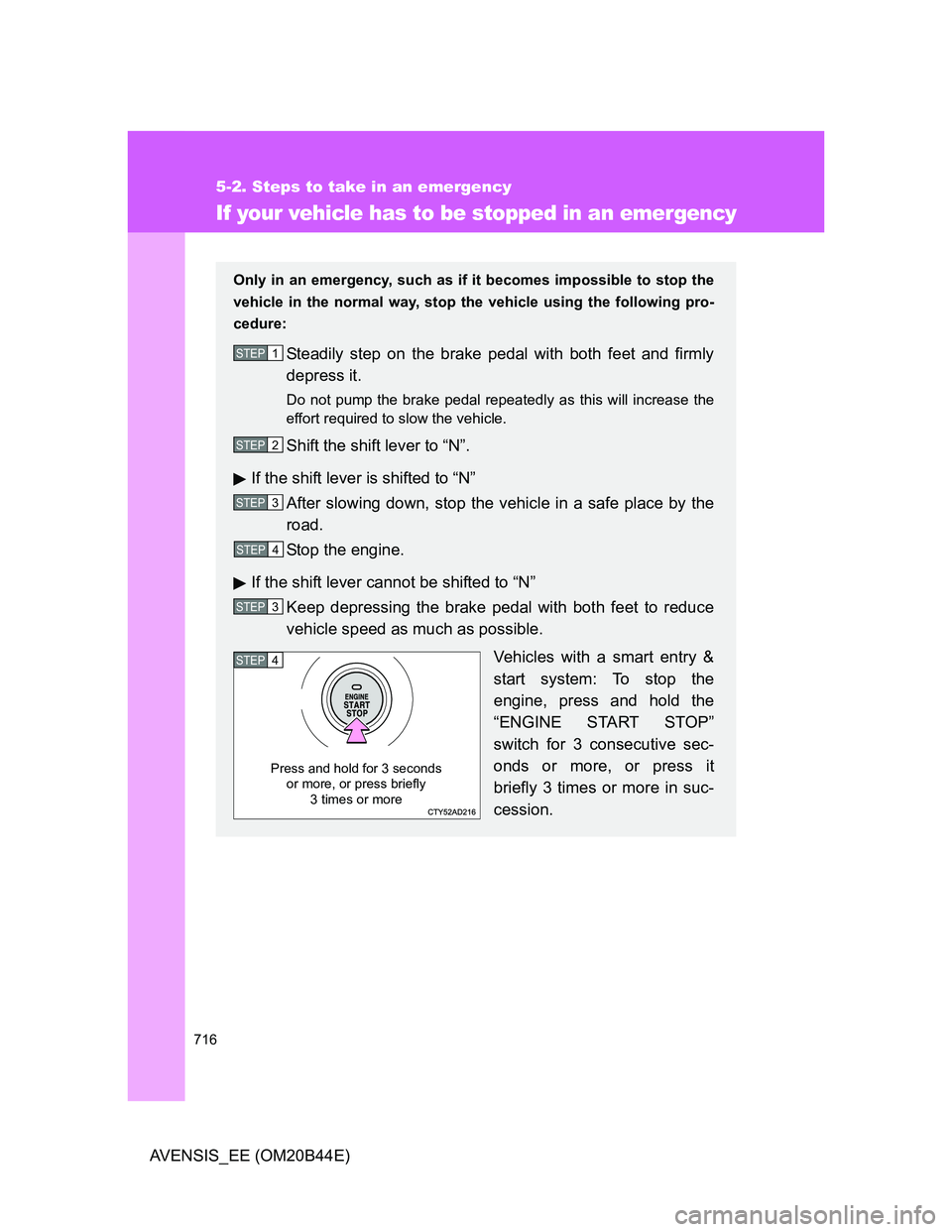
716
5-2. Steps to take in an emergency
AVENSIS_EE (OM20B44E)
If your vehicle has to be stopped in an emergency
Only in an emergency, such as if it becomes impossible to stop the
vehicle in the normal way, stop the vehicle using the following pro-
cedure:
Steadily step on the brake pedal with both feet and firmly
depress it.
Do not pump the brake pedal repeatedly as this will increase the
effort required to slow the vehicle.
Shift the shift lever to “N”.
If the shift lever is shifted to “N”
After slowing down, stop the vehicle in a safe place by the
road.
Stop the engine.
If the shift lever cannot be shifted to “N”
Keep depressing the brake pedal with both feet to reduce
vehicle speed as much as possible.
Vehicles with a smart entry &
start system: To stop the
engine, press and hold the
“ENGINE START STOP”
switch for 3 consecutive sec-
onds or more, or press it
briefly 3 times or more in suc-
cession.
STEP1
STEP2
STEP3
STEP4
STEP3
STEP4
Press and hold for 3 seconds
or more, or press briefly
3 times or more
Page 717 of 772
5
717 5-2. Steps to take in an emergency
When trouble arises
AVENSIS_EE (OM20B44E)
CAUTION
If the engine has to be turned off while driving
Power assist for the brakes and steering wheel will be lost, making the
brake pedal harder to depress and the steering wheel heavier to turn.
Decelerate as much as possible before turning off the engine.
Vehicles without smart entry & start system: Never attempt to remove the
key, as doing so will lock the steering wheel.
Vehicles without smart entry &
start system: Stop the engine
by turning the engine switch to
the “ACC” position.
Stop the vehicle in a safe place by the road.STEP4
STEP5
Page 718 of 772
718 5-2. Steps to take in an emergency
AVENSIS_EE (OM20B44E)
Page 719 of 772
6Vehicle specifications
719
AVENSIS_EE (OM20B44E)
6-1. Specifications
Maintenance data
(fuel, oil level, etc.).......... 720
Fuel information ................ 745
6-2. Customization
Customizable
features........................... 749
6-3. Initialization
Items to initialize ............... 754
Page 720 of 772
720
AVENSIS_EE (OM20B44E)
6-1. Specifications
Maintenance data (fuel, oil level, etc.)
Dimensions and weights
Overall lengthSedan 4710 mm (185.4 in.)
Wagon 4780 mm (188.2 in.)
Overall width 1810 mm (71.2 in.)
Overall height*11480 mm (58.2 in.)
Wheelbase 2700 mm (106.3 in.)
Tread
Front1560 mm (61.4 in.)*2
1550 mm (61.0 in.)*3
Rear1550 mm (61.0 in.)*2
1540 mm (60.6 in.)*3
Gross vehicle
mass
1ZR-FAE engine 1950 kg (4298.9 lb.)
2ZR-FAE engine2020 kg (4453.3 lb.)*4
2000 kg (4409.2 lb.)*5
3ZR-FAE engine2050 kg (4519.4 lb.)*4
2020 kg (4453.3 lb.)*5
1AD-FTV engine2100 kg (4629.7 lb.)
2130 kg (4695.8 lb.)*6
2AD-FTV and
2AD-FHV engines2140 kg (4717.8 lb.)
Maximum permis-
sible axle capacityFront1215 kg (2678.6 lb.)*7
1250 kg (2755.7 lb.)*8
Rear1135 kg (2502.2 lb.)*7
1215 kg (2678.6 lb.)*8
Trending: fuel, wipers, oil temperature, audio, climate control, deactivate airbag, fuel pressure
